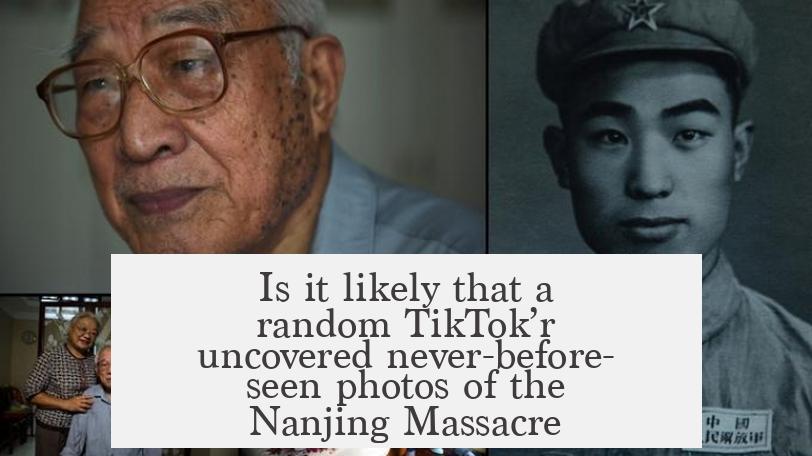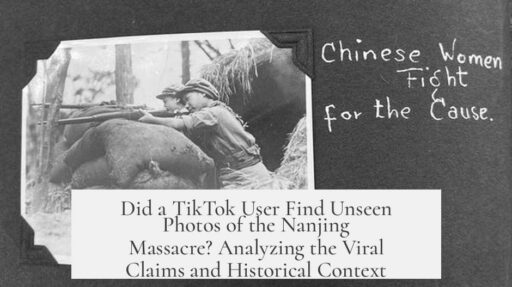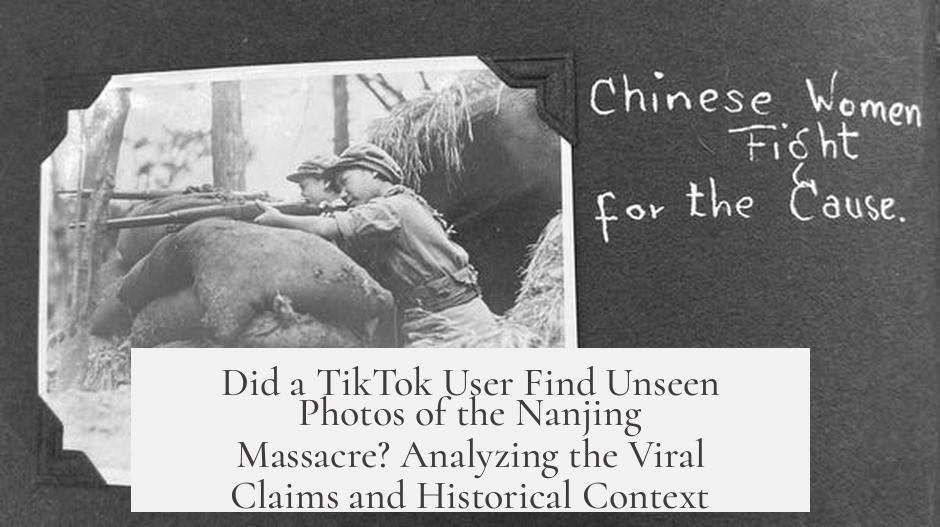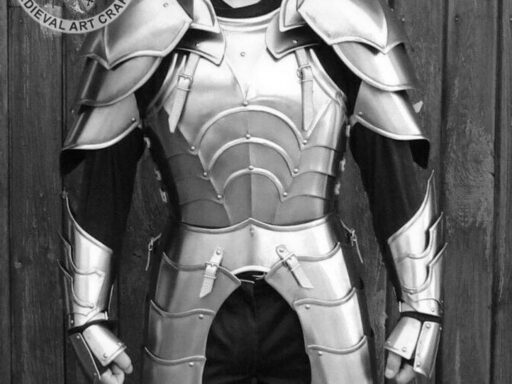It is very unlikely that a random TikTok user uncovered never-before-seen photos of the Nanjing Massacre. The photo album shared online appears genuine but is far from rare or unique. Such albums, often labeled “my oriental,” were commonly sold or given to US sailors during their tours in the 1930s. These albums frequently contained a mix of personal photos, souvenirs, and widely circulated images, many related to historical events in East Asia but not exclusive to the Nanjing Massacre.
Extensive checks including reverse image searches reveal most, if not all, photos shared by the TikToker have been public for years. Some images appear on stock photo websites or auction listings. Many depict events unrelated to the 1937 Nanjing Massacre, such as public executions from earlier decades or scenes from different locations or periods. For example, one photo identified as a “death of a thousand cuts” likely shows the execution of Fu Zhuli in 1905. This diversity of content suggests the album compiles various images rather than a focused, original photographic record of the massacre.
The sailor who owned the album reportedly served aboard the USS Augusta, which did not visit Nanjing during the massacre. This fact strongly indicates the sailor was not the photographer of any massacre-related images. Back then, travelers and sailors often bought newsworthy photographs or postcards, including graphic scenes, to create personal scrapbooks. This practice predates widespread portable cameras, limiting the likelihood of firsthand photos of war crimes taken by individuals like this sailor.
The historical context further clarifies the scarcity of authentic photographic evidence from the Nanjing Massacre. Photographic documentation was limited due to technology constraints and political circumstances. Most available atrocity photos came from unknown or unofficial sources and circulated widely, sometimes without precise origin or dates. Professional photographers embedded with the Japanese army focused on propaganda and sanitized images. Chinese photographers operating independently were few, often linked to the Kuomintang (KMT), which did not systematically document the massacre.
Massacre deniers have exploited this limited photo record to question the event’s scale or existence. Many images historically attributed to the massacre are either unrelated to Nanjing or lack proof of Japanese involvement. This incomplete archival landscape fuels public misconceptions about “hidden” or “lost” photos. The TikTok user’s video went viral largely because many viewers were unaware of the well-documented history of these images and the political tensions surrounding the massacre’s remembrance.
Additional information confirms that such photo albums are common historical artifacts. Similar albums and photos have been publicly bought, sold, and indexed online, even including envelopes of execution photos previously published in early 20th-century newspapers. The TikToker’s claim of groundbreaking discoveries has been met with skepticism by historians and experts who have already identified the photos they shared. Even the album’s presenter reportedly acknowledged that the images may not be as unique as initially claimed.
This case illustrates how digital platforms can magnify interest in sensitive historical topics, sometimes leading to enthusiasm unsupported by new evidence. For those studying or interested in the Nanjing Massacre, verified and contextualized sources remain essential for an accurate understanding.
- The album shared by the TikTok user is not rare or unique and contains photos previously available publicly.
- Images in the album show various historical scenes, many unrelated to the Nanjing Massacre.
- The album likely belonged to a US sailor who collected disparate photos, rather than original massacre documentation.
- Photographic evidence of the Nanjing Massacre remains limited and often lacks clear provenance.
- Public excitement stems partly from misconceptions fueled by political sensitivities and incomplete knowledge.
- Experts confirm no new or unseen historical photos emerged from the TikTok post.
Is it likely that a random TikTok’r uncovered never-before-seen photos of the Nanjing Massacre?

Short answer: It’s highly unlikely that any random TikTok user stumbled upon never-before-seen photos of the Nanjing Massacre. The supposed photo album causing a viral buzz online is actually a pretty standard souvenir item from the 1930s with widely circulated and known images. But why does this happen? Let’s dive deeper.
So, you scroll through TikTok and bam! Someone’s waving around a dusty old photo album claiming they’ve found “hidden” pictures of one of the darkest chapters in 20th-century history—the Nanjing Massacre. Naturally, curiosity spikes. Could these images be genuine, previously unseen glimpses into untold horrors? Or is it just another internet mirage? Spoiler alert: it leans heavily toward the latter.
The Album: Not a Time Capsule, Just a Souvenir
The album shared online looks genuine—no question. But here’s a kicker: it’s not rare in any meaningful sense. We’re talking about what’s known as a “My Oriental” album, something quite common among US sailors in the 1930s. These albums were either bought or gifted as souvenirs before tour duty. They were basically the 1930s travel photo book equivalent of your Aunt Susan’s holiday postcards.
You can find virtually identical albums online, sometimes empty, sometimes filled with similar content. For example, auction websites and eBay have listings with these albums, and many collectors have noted their abundance. So, the idea you’re looking at a one-of-a-kind artifact? Not really on the table here.
Photos in the Album: Known, Previously Seen, or Unrelated
The content itself doesn’t help the mystery either. Experts who’ve done reverse image searches quickly identified every photo as previously known. Some appear on stock photo sites, others are from well-documented archives. The images are a mix—some from events dating back to the 1920s, some showcasing grisly executions like “the death of a thousand cuts,” likely the 1905 execution of Fu Zhuli, but nothing fresh or directly tied to the actual Nanjing Massacre documented in 1937.
Moreover, the owner of the album reportedly served on the USS Augusta—an important detail because records suggest the Augusta wasn’t even in Nanjing at the time of the massacre. This fact makes it very unlikely the photos were taken by the album’s owner or during that event.
A Snapshot of the Era: Collecting Gruesome Souvenirs Was Common

The 1930s weren’t exactly the era of selfies and portable cameras, so snapping pics of unfolding atrocities wasn’t easy. Instead, travelers and sailors often bought postcards or printed photos of sensational or newsworthy events, including executions and military actions. These items were collected like badges or souvenirs, tucked into personal albums alongside family photos and holiday snaps.
This means the album functions more like a curated scrapbook of what was available at the time rather than an exclusive photographic diary uncovering anything unknown. Putting graphic executions next to a photo of Auntie Deirdre by the Christmas tree might seem bizarre today, but back then, it was relatively normal.
Historical Context: Why Genuine Photos Are Rare and Circulate Poorly
Here’s where history throws a curveball. Photographic evidence from the Nanjing Massacre is in poor shape overall. The scarcity is real and partly why these viral videos capture so much attention. Images of the massacre circulated in printed form, were reproduced for sale as souvenirs, or found secondhand via unknown sources. Many lack proper attribution, causing skepticism and fuel for massacre denial among some groups, especially certain factions in Japan.
Most frontline photographers with Japanese troops were sympathetic to their cause, focusing on positive propaganda rather than documenting war crimes. Meanwhile, the Chinese population had very few photographers, and the KMT (Chinese Nationalists) did not actively document the massacre photographically. The genuine photos that do exist mostly come from foreign nationals—Americans and Europeans residing in occupied cities.
Why Does This Viral Album Cause a Stir?
Wondering why millions of viewers got excited anyway? It boils down to awareness. Many people watching TikTok, especially globally, might have never heard of the “Rape of Nanking.” The subject, while notorious in certain circles, isn’t as widely discussed worldwide as other historical atrocities.
The narrative of “hidden history” or “never-before-seen” photos always sparks interest. Add the politically charged nature between Chinese and Japanese perspectives, where denial and acknowledgment clash fiercely, and the recipe for viral content is complete. The emotional charge drives people to share, discuss, and sometimes misinterpret what they see.
Lessons from Additional Research and Updates

Further investigations into this album reveal more known content. Articles surfaced identifying several photos and tracing their origins to earlier publications, including an envelope from 1915 San Francisco containing “Actual photographs of Chinese Executions.” These images even match some photos found in the album in question, proving they are far from new discoveries.
The original TikTok user (or ‘pawnman,’ as some reports amusingly call him) seems to have accepted that some photos may depict events other than the Nanjing Massacre, as noted in follow-up NBC articles. The willingness to revise claims helps clarify misunderstandings, showing that viral content often benefits from careful fact-checking.
So, What’s the Real Takeaway?
If you hoped that a random TikToker cracked open a vault of unseen horrors from 1937, it’s a bummer to hear but the likelihood is very low. The album and photos belong to a broad category of atrocity images that were widely sold, collected, and circulated throughout the early 20th century. They’re more catalogue than exclusive find.
But here’s the thing—this doesn’t diminish their importance as historical artifacts or the significance of remembering the Nanjing Massacre itself. The album serves as a window into how people back then engaged with history, using available media to document or simply collect fragments of major events.
What Can We Learn From This Viral Moment?
- Always fact-check viral historical claims. Just because something looks old or dramatic doesn’t make it new or unique.
- Understand the context. Historical evidence, especially photographic, often has complex origins and circulation paths.
- Stay curious but cautious. It’s fantastic to see renewed interest in important history like the Nanjing Massacre, but sensationalism can cloud facts.
- Use such discussions to educate. When the next “hidden history” explodes online, take time to explore what’s credible and what is hype.
In Closing:
The viral TikTok photo album is not a discovery of “never-before-seen” Nanjing Massacre photos. Instead, it’s a common souvenir album mixed with well-known images, some from entirely different events, that has caught attention for valid but slightly misguided reasons.
Next time you see an alleged “hidden history” treasure, remember—it’s often the context and conversation that count more than the novelty.
Is the photo album shared by the TikTok user rare or unique?
No, the album is not rare. Similar albums from the 1930s are common. Many were sold or given to US sailors and can be found online or for sale.
Do the photos in the album show new images of the Nanjing Massacre?
The photos are mostly known or unrelated. Many have been seen before and appear in public collections or stock photo sites. They do not directly show the Nanjing Massacre.
Did the sailor who owned the album likely take the photos?
Unlikely. The sailor served on the USS Augusta, which was not in Nanjing during the massacre. It’s more probable the photos were collected, not taken by him.
Why is the idea of finding hidden Nanjing Massacre photos misleading?
Photo evidence from 1937 is limited and often poorly sourced. Many circulated photos lack clear context, and professional photographers were rare around Nanjing during the massacre.
Why did this TikTok video become popular despite lacking unique photos?
Many people are unaware of the massacre or believe these photos reveal hidden history. The controversy between China and Japan also fuels viral interest.




